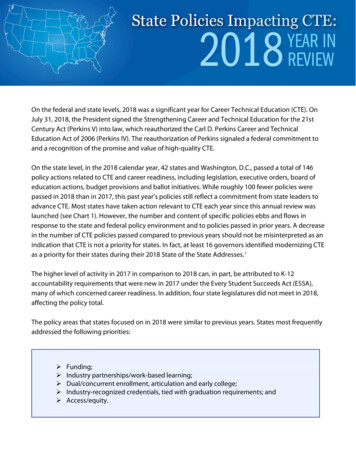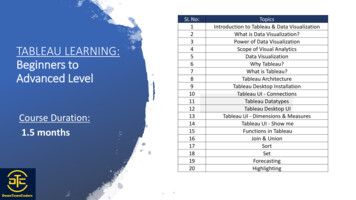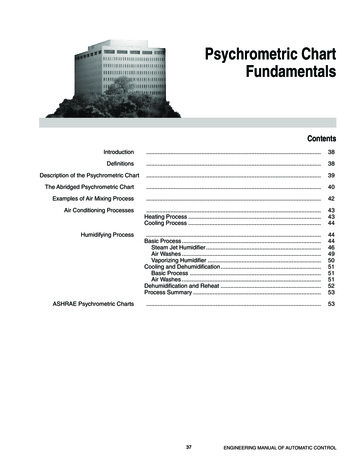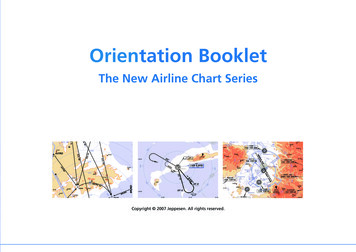
Transcription
On the federal and state levels, 2018 was a significant year for Career Technical Education (CTE). OnJuly 31, 2018, the President signed the Strengthening Career and Technical Education for the 21stCentury Act (Perkins V) into law, which reauthorized the Carl D. Perkins Career and TechnicalEducation Act of 2006 (Perkins IV). The reauthorization of Perkins signaled a federal commitment toand a recognition of the promise and value of high-quality CTE.On the state level, in the 2018 calendar year, 42 states and Washington, D.C., passed a total of 146policy actions related to CTE and career readiness, including legislation, executive orders, board ofeducation actions, budget provisions and ballot initiatives. While roughly 100 fewer policies werepassed in 2018 than in 2017, this past year’s policies still reflect a commitment from state leaders toadvance CTE. Most states have taken action relevant to CTE each year since this annual review waslaunched (see Chart 1). However, the number and content of specific policies ebbs and flows inresponse to the state and federal policy environment and to policies passed in prior years. A decreasein the number of CTE policies passed compared to previous years should not be misinterpreted as anindication that CTE is not a priority for states. In fact, at least 16 governors identified modernizing CTEas a priority for their states during their 2018 State of the State Addresses. 1The higher level of activity in 2017 in comparison to 2018 can, in part, be attributed to K-12accountability requirements that were new in 2017 under the Every Student Succeeds Act (ESSA),many of which concerned career readiness. In addition, four state legislatures did not meet in 2018,affecting the policy total.The policy areas that states focused on in 2018 were similar to previous years. States most frequentlyaddressed the following priorities: Funding;Industry partnerships/work-based learning;Dual/concurrent enrollment, articulation and early college;Industry-recognized credentials, tied with graduation requirements; andAccess/equity.
6025050200401503010020501000201420152016Total states passing CTE-related policies2017Number of statesNumber of policies passed3002018Total CTE-related policies passedChart 1: Number of states passing CTE-related policies and number of CTE-related policies passed, 2014-18This report from Advance CTE and the Association for Career and Technical Education (ACTE) is thesixth annual review of CTE and career readiness policies across the United States. It represents themost comprehensive national snapshot of state activity related to CTE and career readiness andprovides a critical opportunity for state and national leaders to reflect on national trends andconsider future directions.2
Policy CategoryNote: A single bill or policy can address multiplepolicy categories.Number ofStatesAddressingPolicy CategoryFundingPolicies address significant changes in CTE funding, such asincreasing or decreasing allocations, creating a scholarshipor grant program, or investing in a pilot program.30AL, AK, CA, CO, CT, GA, ID, IL, IN, IA, KS, MD,MA, MI, MO, MT, NH, NJ, NY, NC, OK, PA, SD,TN, TX, UT, VT, VA, WA, WI26CO, FL, GA, HI, IN, IA, KY, MD, MA, MI, MO,NV, NJ, NY, NC, OK, OR, PA, RI, SD, TN, UT,VT, VA, WA, WI20CO, GA, ID, IL, IN, IA, KS, KY, MD, MA, MT,NV, NM, NY, OH, OK, TN, VT, VA, WA18AL, AZ, CA, CO, FL, GA, ID, IA, KS, MI, MO,NV, OK, SD, TN, VA, WA, WI18GA, ID, IN, KY, ME, MD, MI, NV, NH, OH, OK,PA, SD, TN, VA, WA, WI, WY17CA, FL, GA, ID, IL, IA, MD, MI, MO, NJ, NY, NC,OK, OR, VT, VA, WA15HI, IL, IN, IA, MD, MI, MO, NC, OH, OK, OR,PA, TX, VT, WY14AL, CO, ID, IN, MI, MO, NV, OH, OK, OR, TN,VT, VA, WA13AL, IL, IN, MO, NH, NM, NY, OK, UT, VT, VA,WA, WI11GA, HI, IA, MO, NY, OH, OK, PA, TN, VA, WY10DC, FL, MD, MA, MO, NH, OH, VA, WA, WY10AL, HI, ID, IA, MD, MO, OK, PA, VA, WAIndustry Partnerships/Work-Based LearningPolicies address engaging industry to drive student learningthrough work-based learning or other means.Dual/Concurrent Enrollment, Articulation andEarly CollegePolicies address student transition to the next level ofeducation through dual/concurrent credit attainment,credit transfer agreements and early college programs.StatesIndustry-Recognized CredentialsPolicies address attainment of credentials recognized byindustry, including micro-credentials, such as badges, andeducational degrees.Graduation RequirementsPolicies address CTE as an optional or required avenue forearning academic credit and/or meeting high schoolgraduation requirements, including diploma endorsementsand seals.Access/EquityPolicies address access to CTE as well as strategies thatsupport success within CTE for specific populations.CTE Teacher Certification/DevelopmentPolicies address the recruitment, preparation, certificationand professional development of CTE faculty and staff.Career/Academic CounselingPolicies address career awareness, exploration andguidance and counseling, including academic and careerplanning and career awareness activities.GovernancePolicies address responsibility within the state for CTE,including new committees or task forces and transfers ofauthority.CTE Standards/AccreditationPolicies address defining the knowledge and skillsdeveloped by CTE, including curriculum standards,standards for work-based learning and postsecondaryaccreditation.Data, Reporting and/or AccountabilityPolicies address data and research activities that supportCTE, including the use of labor market information and theinclusion of career readiness within accountability systems.STEMPolicies explicitly address Science, Technology, Engineeringand Mathematics (STEM) education.Table 1: Number and postal abbreviations of states adopting new CTE-related policies in 2018, by policy category
learning opportunities. Oklahoma created a statework-based learning program to coordinateopportunities through the state labor market andlabor exchange systems and to develop industryspecific standards as well as standards for equityand access in work-based learning.Key TakeawaysIn total, 30 states enacted policies in 2018 thataffected CTE funding, making funding the mostpopular policy category for the sixth year in a row.California directed 150 million to makepermanent the Career Technical EducationIncentive Grant program, which supports new orexpanded high-quality K-12 CTE programs, whilevoters in New Jersey approved a ballot initiativefor 500 million in state bonds to expandsecondary and postsecondary CTE programs,among other activities. A number of states,including California, Iowa, Maryland, Michigan,Missouri, New Jersey and North Carolina,directed funding toward the needs of underrepresented, low-income or otherwisedisadvantaged populations. Washingtonestablished a scholarship program to supportfoster and homeless youth entering postsecondaryeducation or pursuing an apprenticeship, amongother policies that supported access and equity,and New York is funding 15 early college highschool programs aligned with in-demandindustries in communities with low rates ofgraduation or postsecondary transition. Severalstates, including Indiana, Maryland andPennsylvania, directed funds toward providingmore computer science education and relatedprofessional development for teachers.Within work-based learning, apprenticeships werespecifically targeted by a number of states. Iowafunded a program to encourage small andmedium-sized businesses to develop registeredapprenticeships, while Maryland expandedstatewide its Apprenticeship Maryland Program,which provides youth apprenticeships associatedwith career pathways in manufacturing andscience, technology, engineering and math (STEM).Oregon, Pennsylvania and Washington alsoacted to expand or promote apprenticeships, preapprenticeships or youth apprenticeships.The third-ranked policy category wasdual/concurrent enrollment, articulation and earlycollege, with 20 states passing policies in thiscategory. Montana announced a program to offerhigh school students two free dual enrollmentcourses through the Montana University System,while Idaho is aligning 15 CTE programs to enableseamless transition from secondary topostsecondary education. New legislation inVirginia calls for the development of qualitystandards for dual enrollment courses and aprocess for determining the type of credit that willbe awarded for successful completion of thesecourses. In addition, several states modifiedeligibility for dual and concurrent enrollmentprograms. Illinois passed legislation to allowstudents to take an unlimited number of dualenrollment/dual credit courses, while Oklahomaexpanded the number of credits for whichstudents can use tuition waivers. On the otherhand, Ohio added restrictions to its College CreditPlus program to help ensure student success andThe second most popular policy category wasindustry partnerships and work-based learning,with 26 states taking action in this area. Thiscategory includes business-education partnershipsoverall and work-based learning as a primarystrategy for connecting students with businesses.Missouri created a one-year teaching certificatefor visiting scholars from industry who are part of abusiness-education partnership and have relevanteducation credentials, while legislation in Indianaand Iowa calls on consortia of business andeducation stakeholders to expand work-based4
student organizations. States also took action torecognize CTE, and computer science courses inparticular, for core academic credit, as in NewHampshire, Ohio, Oklahoma, Pennsylvania,South Dakota, Washington and Wyoming. Forinstance, students in New Hampshire can nowmeet mathematics requirements by completingthree math courses and an approved CTE coursethat integrates math knowledge and skills. Inaddition, Maryland and Wisconsin createdpolicies to award credit for work-based learning.prevent the state from paying for coursework thatdoes not result in credit attainment.Two policy categories share the next position, with18 states taking action related to industryrecognized credentials and 18 states passingpolicies that address CTE as part of graduationrequirements. Within the industry-recognizedcredentials category, new legislation in Missouriauthorizes schools to incorporate industrycertification exams when developing CTEpathways, and Virginia now permits local schooldivisions to waive the 140-clock-hour requirementfor earning a standard unit of credit if a student hascompleted the course curriculum and relevantend-of-course assessment and is working towardan approved industry certification. In addition,Colorado extended its incentive program thatprovides up to 1,000 to school districts for eachhigh school student who earns an industryrecognized credential or completes an AdvancedPlacement (AP) computer science course or workbased learning experience.Rounding out the top policy categories, 17 statesenacted policies related to CTE access/equity.Several policies that support access and equity fordisadvantaged populations are described in thefunding section above. In addition, legislation inFlorida enables the state Department ofCorrections to partner with local school districtsand the Florida College System to provideprisoners with postsecondary CTE, while Virginianow requires the state Department of Education toestablish a list of testing accommodationsavailable to English language learners forassessments that satisfy the CTE credentialgraduation requirement.Iowa and Oregon took action to provide workbased learning experiences for disadvantaged ornon-traditional students. 23Policies in the graduation requirements categoryinclude CTE and CTE-related options fordemonstrating career and college readiness, aswell as diploma endorsements that recognize CTEparticipation, as in Georgia, Indiana, Kentuckyand Nevada. Under new requirements in Indiana,high school graduates must exhibit employabilityskills through project-based, service-based orwork-based learning and demonstratepostsecondary readiness through participating inan apprenticeship or reaching CTE concentratorstatus, among other options. Georgia’s CareerReady Diploma Seal is endorsed by businesspartners and recognizes students for a variety ofCTE-related activities, including completion of astate-recognized soft skills program; completion ofa Career, Technical and Agricultural Educationpathway; and participation in career and technical5
Spotlight on State CTE Computer Science PolicyDigital literacy and computer science skills are increasingly necessary for success in today’s workforce,even in fields that are not directly related to information technology. State leaders are recognizing the rolethat a robust computer science education strategy plays in preparing learners for their future careers.National initiatives have emerged to help states promote computer science education to prepare learnersfor the labor market. Fifteen governors have joined the Governors for K-12 Computer Science initiative,which focuses on increasing access to K-12 computer science education.2 Additionally, the SouthernRegional Education Board established the Commission on Computer Science and Information Technologyto help states expand access to challenging educational experiences in the fields of computer science,information technology and cybersecurity.3Given the national and state focus on computer science, unsurprisingly, numerous states passed policiesrelated to computer science during their 2018 legislative sessions. In total, 13 states passed 16 policiesrelated to computer science in 2018. Of the 16 policies that were enacted, seven were related to computerscience standards, five were related to providing professional development to teachers or creating a talentpipeline to increase the number of teachers qualified to teach computer science, and four directed statesor districts to develop and implement computer science curriculum or courses.For instance, in Hawai’i, the Legislature passed H.B. 2607, which requires the state Department ofEducation to develop and implement statewide computer science curricula plans for K-12 students andensure that by the 2021-22 school year each public high school offers at least one computer sciencecourse in each school year.In Indiana, the Legislature passed S.B. 172, which establishes the Next Level Computer Science Fund andNext Level Computer Science Grant Program to help eligible entities implement professionaldevelopment programs for teaching computer science. The bill also requires public schools and charterschools to offer a computer science course as an elective course by 2021.YearPoliciesStates201816HI, IN, IA, MD, MO, NY, OH, OK, PA, SD, TN, VA, WY20177CO, ID, KY, MD, NV, NC, VA201611AR, CA, CO, FL, ID, IL, IN, NJ, UT, VA, WATable 2: Computer science policies, 2016-186
workforce development, and 13 policies related toadult education.Systems Affected by PolicyDevelopmentsFor the second year in a row, this reportcategorizes policies by the systems affected:secondary education, postsecondary education,workforce development and adult education. Asingle policy can address multiple systems.As in 2017, more policies affected the secondarysystem than any other systems. However, roughlyone out of every four policies in 2018 were relevantto multiple systems. While this percentage is adecrease from the prior year, in which roughly oneout of every three policies were relevant tomultiple systems, it still indicates a continuedpattern of collaboration between and acrosseducation levels and state agencies.In 2018, states passed 120 policies related tosecondary education, 54 policies relevant topostsecondary education, 26 policies affectingSystemPoliciesSecondary education120Postsecondary education54Workforce development26Adult education13Table 3: 2018 state CTE-related policies, by system. A single policy can address multiple systems.This paper was prepared by Advance CTE and the Association for Career and Technical Education (ACTE), andprovides an overview of CTE-related state policies enacted in 2018.While many of the highlighted state actions may have positive implications for CTE, the inclusion of policies withinthis publication does not imply an endorsement by ACTE, Advance CTE or state CTE leaders.7
AlabamaH.B. 175, for the fiscal year ending on September 30, 2019, appropriates 5.46 million for CTE initiatives,including appropriations for the following: 1.70 million to expand the Career Coaches Program, which increases youth awareness of careeropportunities by pairing students with career coaches who help them explore the 16 Career Clusters ; 400,000 to expand the Agribusiness Education Program; and 794,372 to support Imagine Academy, which allows students to earn industry-recognized STEMcredentials in high school.H.B. 170 revises the Alabama Workforce Council membership qualifications and adds the State CTE Director asa non-voting member of the Council.AlaskaAlaska’s Fiscal Year (FY) 2019 budget decreases allocations for the Alaska Vocational Technical Center by 171,900.American SamoaNo relevant CTE policy was adopted in 2018.ArizonaAt the direction of Gov. Doug Ducey, a team with representation from the Arizona Office of EconomicOpportunity, Arizona Commerce Authority and Department of Economic Security introduced the ArizonaCareer Readiness Credential. The Arizona Career Readiness Credential is an employer-recognized credentialthat job seekers can earn by validating the following foundational skills via assessments: applied mathematics,workplace reading, workplace data and graphics, effective communication, critical thinking and problemsolving, teamwork and collaboration and attitude. The credential is targeted toward recent high schoolgraduates and those between the ages of 35 and 44.H.B. 2526 replaces “joint technical education program” language with “career technical education” languagein state definitions in relation to education districts.ArkansasNo relevant CTE policy was adopted in 2018.CaliforniaCalifornia’s FY 2018-19 budget includes: 164 million in ongoing Proposition 98 funding to establish a K-12 component within the StrongWorkforce Program, an initiative that aims to improve CTE programs and increase the number oflearners enrolled in CTE programs that culminate in high-wage, in-demand jobs; 6.70 million in general funds to offer 338 additional CTE programming slots and to expand CTE to 13additional sites in California;8
1.50 million in general funds for related CTE equipment replacement in correctional facilities; 100 million in one-time and 20 million in ongoing Proposition 98 general funds to establish astatewide online community college; and 150 million in ongoing Proposition 98 general funds to make permanent the Career TechnicalEducation Incentive Grant, which encourages the creation and expansion of high-quality CTEprograms during local education agencies’ implementation of the Local Control Funding Formula.The budget also adopts a new funding formula that provides funding to districts for each student who meetscertain student success metrics, which include completion of a degree or certificate, and providessupplemental funding to districts that serve low-income students.ColoradoExisting law requires schools and districts to notify students and their parents of concurrent enrollmentopportunities. New legislation, H.B. 1005, requires the notification to include information pertaining to localeducation providers’ timelines that affect students’ ability to take postsecondary concurrent enrollmentcourses and a statement on the financial, academic and career benefits of taking concurrent enrollmentcourses.H.B. 1086 allows community colleges to offer a bachelor of science degree in nursing with the state board forcommunity colleges and occupational education’s approval. This bill passed without the governor’s signature.The FY 2019 budget increases appropriations for CTE by 510,789 for a total appropriation of 16.68 million.H.B. 1266 extends the repeal date another five years for the career development success program, whichprovides up to 1,000 to school districts for each high school student who completes an industry certificate,AP computer science course, internship or pre-apprenticeship program. The bill places a limit on the amountof funds a school district can receive for each student who completes an industry certificate and requiresparticipating school districts to explain the program to all high school students.ConnecticutConnecticut’s FY 2019 budget increases the annual state grant for each student enrolled in an AgriculturalScience and Technology Education Center from 3,200 to 4,200.DelawareNo relevant CTE policy was adopted in 2018.District of ColumbiaB. 22-0401 requires the District’s Workforce Investment Council to detail the District’s spending on adult andworkforce development education programs, as well as the performance outcomes of those programs, in apublic report. The performance outcomes information will include employment rates, median earnings,credential attainment and completion rates.9
FloridaH.B. 1201 allows the Florida Department of Corrections to partner with local school districts and the FloridaCollege System to provide prisoners with postsecondary education and vocational training.The Florida Excellence in Higher Education Act of 2018, S.B. 4, directs each state university to use data-drivengap analyses to identify industry mentorship, internship, certification and employment opportunities forstudents at their institutions.GeorgiaS.B. 186 makes students pursuing an associate degree at a branch of the Technical College System of Georgiaeligible for a HOPE grant if they received a high school diploma through the completion of a technical collegediploma program and all postsecondary education and training prerequisites for an occupational certificationor licenses required to work in the field. Students are also eligible if they completed at least two technicalcollege certificate of credit programs in a career pathway and all postsecondary education and trainingprerequisites for an occupational certification or licenses required to work in the field. The HOPE grant can beused to cover up to 30 degree hours of an associate degree.S.B. 3 amends the Creating Opportunities Needed Now to Expand Credentialed Training (CONNECT) Act torequire the State Board of Education to prescribe a minimum course of study in career education for grades 612 rather than K-12. The law outlines experiences that include career-oriented learning and requires the StateBoard of Education to ensure that career-oriented learning includes industry credentialing. The law requiresthe State Board of Education to establish industry-required content standards in consultation withbusiness/industry, the Technical College System of Georgia and the University System of Georgia that alignwith postsecondary opportunities. The law directs the State Board of Education to establish a competitivegrant program for the purchasing of equipment to enhance programs that have or are in the process ofachieving industry certification.The Georgia Department of Education approved a series of gold seals, the Georgia Career Ready DiplomaSeals, to be provided to high school graduates who complete a series of accomplishments and engage inactivities, courses and experiences that encourage career readiness such as completion of a state-recognizedsoft skills program; completion of a Career, Technical and Agricultural Education pathway; and participation incareer and technical student organizations. The seals are endorsed by business/industry partners and includethe following versions: Employability/Soft Skills Seal, Distinguished Employability/Soft Skills Seal, PathwaySkills Seal, Distinguished Pathways Skills Seal, Leadership Skills Seal and Distinguished Leadership Skills Seal.S.B. 330, the Georgia Agriculture Education Act, directs the state Department of Education to developcurriculum and standards for the agricultural education program provided to students in grades 6-12. The lawdictates that the program be based on a three-component model of school-based agricultural education: dailyinstruction in an organized classroom and lab environment; hands-on, experiential learning through asupervised agricultural experience; and leadership and learning opportunities through participation in theGeorgia FFA Association, the National FFA Organization and agricultural education. The law also authorizesthe Department of Education to establish a pilot agricultural education program in elementary schools,10
beginning in the 2019-20 school year. The law directs the Department of Education and local school systemsto collaborate to develop the curriculum for each elementary agricultural education program. TheDepartment of Education must evaluate the pilot programs at the end of their third year and provide theresults to House and Senate committees.GuamNo relevant CTE policy was adopted in 2018.Hawai’iThe Hawai’i Board of Education adopted the national Computer Science Teachers Association’s K-12Computer Science Standards.S.B. 2051 allows schools or career pathways, programs or academies operated within a school to engage incommercial enterprises related to their primary educational purpose.H.B. 2607 requires the Department of Education to develop and implement statewide computer sciencecurricula plans for public school students in kindergarten to grade 12 and ensure that by the 2021-22 schoolyear each public high school offers at least one computer science course in each school year. The law alsoallows the Department of Education to enter into a contract with entities to develop and implement acomputer science teacher development program.IdahoS.B. 1222 creates a section in the Idaho Code to provide quality program funding for CTE secondary programsin business management and marketing, engineering and technology, family and consumer sciences, healthsciences, and skilled and technical sciences areas. The bill directs the Division of Career Technical Education toprovide technical assistance funding to the aforementioned programs. Additionally, the bill establishes theCareer Technical Education Program Quality and Workforce Readiness Incentive Program, which requires theDivision of Career Technical Education to develop criteria to award incentive funding directly to secondaryCTE teachers based on the number of secondary CTE concentrators who demonstrate workforce readinessupon completion of their CTE program.S.B. 1279 expands the Idaho Opportunity Scholarship to benefit adult learners. The scholarship originallybenefitted only recent Idaho high school graduates, but the bill will allow the State Board of Education todirect up to 20 percent of scholarship funds to Idaho adult residents striving to finish a degree or certificate.S.B. 1212 revises terminology related to CTE and specifies that “CTE” is defined to include courses or programstaught in grades seven and eight. Until this legislation passed, CTE in Idaho started in the ninth grade. Thegoal of the expanded CTE middle school program will be to focus on career exploration.S.B. 1267 establishes a STEM diploma and specifies the required coursework students must complete to obtainthe diploma.11
Idaho’s FY 2019 budget: Appropriates an additional 2 million for college and career counseling at Idaho high schools; Appropriates 300,000 to expand funding to secondary CTE programs that go beyond the statutorilyauthorized agricultural and natural resources education programs to include business managementand marketing, engineering and technology, family consumer sciences, health sciences, and/or skilledand technical sciences; Provides funding for an additional 15 CTE programs to assist CTE students in transitioning directlyfrom secondary to postsecondary programs; Transfers funds from CTE and appropriates funds to the newly formed College of Eastern Idaho, whichis now a community college and was previously Eastern Idaho Technical College; Appropriates 1.68 million for six postsecondary institutions in the state to build CTE training capacity; Provides 70,000 to develop four online courses through the Idaho Digital Literacy Academy tocontinue efforts to develop online CTE classes; Appropriates 176,900 to fund two positions within the Idaho Division of Career Technical Educationto develop a middle school career exploration program; and Appropriates 750,000 to provide additional administrative support for Workforce Training Centers.IllinoisS.B. 2838 creates a Dual Credit Committee, which includes representation from the Illinois Community CollegeBoard and the State Board of Education, to develop a Model Partnership Agreement for dual creditpartnerships between community colleges and school districts. The law directs a community college district toenter into a partnership agreement with a school district to offer dual credit coursework upon the request of aschool district within the community college district’s jurisdiction. The law outlines the requirements of thepartnership agreement and stipulates that if the school district and community college district cannot enterinto a partnership agreement within 180 days of the school district’s initial request, then they must implementthe Model Partnership Agreement. This law prevents a school district from entering into a dual credit contractwith an out-of-state institution without first offering the local community college district an opportunity toenter into a dual credit contract.In addition, the law outlines the standards that institutions offering dual credit must meet, which include thata CTE instructor must possess the credentials and demonstrated teaching competencies appropriate to thefield of instruction. Finally, the law directs the Illinois Community College Board, subject to appropriation, toaward community c
On the federal and state levels, 2018 was a significant year for Career Technical Education (CTE). On July 31, 2018, the President signed the Strengthening Career and Technical Education for the 21st Century Act (Perkins V) into law, which reauthorized the Carl D. Perkins Career and Technical Education Act of 2006 (Perkins IV).











